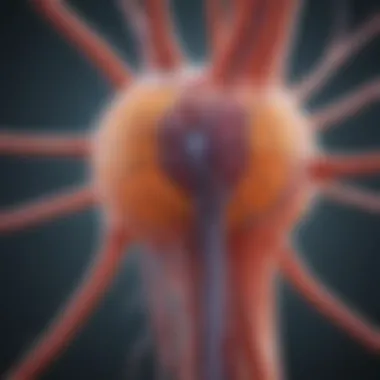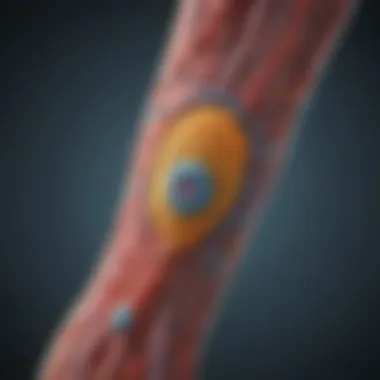Understanding Immune Neuropathy: Mechanisms and Treatment


Intro
Immune neuropathy represents a complex intersection of the immune system and nervous system, where immune dysfunction leads to various degrees of nerve damage. This condition manifests through a range of symptoms, including weakness, numbness, and pain in the affected areas. Understanding the underlying mechanisms, accurate diagnosis, and potential treatment options is essential for managing this challenging condition.
Recent advancements in research have shed light on the biological pathways involved in immune neuropathy. By investigating these pathways, scientists have made significant strides in diagnosing and treating patients more effectively. This article presents an analytical overview, targeting both academic and non-academic readers, to unravel the intricate layers of immune neuropathy.
Foreword to Immune Neuropathy
Immune neuropathy is a critical area of study that examines how the immune system can harm the peripheral nervous system. Understanding this topic is essential for healthcare professionals, researchers, and even patients. The significance lies in its multifaceted nature, combining immunology with neurology. As the medical community learns more about this condition, both diagnosis and treatment methods evolve. This section provides a grounding in the definition and background of immune neuropathy, paired with its epidemiological context, to set a solid foundation for further exploration.
Definition and Background
Immune neuropathy refers to a group of disorders wherein the immune system mistakenly targets and damages nerve tissues. This condition can arise from various underlying factors, including autoimmune diseases, infections, or even adverse reactions to medications. Understanding immune neuropathy is crucial because it emphasizes the delicate balance within the immune system. When dysregulated, it can lead to significant impairment in nerve functionality, causing sensory loss, weakness, and pain. Academic discussions on this topic often center around the mechanisms that drive these immune responses and the subsequent nerve injury. Moreover, a solid grasp of the definitions and context is vital for future discussions on diagnosis and treatment strategies.
Epidemiology of Immune Neuropathy
Statistical data regarding immune neuropathy is important for grasping its impact. The prevalence of these conditions varies across populations and can influence public health policies. Research indicates that immune neuropathy can affect individuals of any age; however, certain autoimmune disorders are more common in particular demographics. For example, Guillain-Barré syndrome, one specific type of immune neuropathy, appears more frequently after infections. Studies show that the incidence can be higher post viral infections, such as Zika or influenza.
It is also essential to note that access to healthcare can affect diagnosis rates. Socioeconomic factors may lead to under-diagnosis in some communities. Given the variety of presenting symptoms, subtle cases may not always be recognized promptly.
Immune neuropathy might affect movement and sensation, significantly impacting individual quality of life.
Understanding epidemiology lays the groundwork for recognizing patterns in disease manifestation. Such recognition can eventually inform better therapeutic approaches, adapted to the needs of specific patient populations.
Underlying Mechanisms
Understanding the underlying mechanisms of immune neuropathy is critical to grasp how the condition arises and progresses. Autoimmune processes, inflammatory pathways, and genetic predispositions play significant roles in the development of nerve damage. Identifying these mechanisms aids in not only diagnosis but also the formulation of effective treatment strategies. This section will highlight the intricate relationship between these factors, their clinical implications, and areas for further research.
Autoimmune Responses and Nerve Damage
Autoimmune responses occur when the body's immune system mistakenly targets its own tissues. In immune neuropathy, this misdirected response can lead to nerve damage through several pathways. Key immune cells, such as T cells and B cells, may infiltrate the peripheral nerves, causing inflammation and structural damage.
The process often starts with the recognition of nerve antigens by immune cells. This recognition triggers a cascade of reactions that result in the destruction of the myelin sheath, which surrounds and protects nerve fibers. Consequentially, the loss of myelin can lead to impaired signal transmission along nerves, which contributes to various symptoms observed in patients.
Notably, the relationship between specific autoimmune conditions and neuropathy is well established. Conditions such as Guillain-Barré syndrome and Chronic Inflammatory Demyelinating Polyneuropathy (CIDP) exemplify this link. Effective understanding of these autoimmune responses enables clinicians to target therapies that can modify the immune response and prevent further nerve damage.
Inflammatory Pathways Involved
The inflammatory pathways activated in immune neuropathy are complex and multifactorial. Cytokines, chemokines, and various immune mediators are released during the inflammatory response. This release causes additional recruitment of immune cells to sites of damage, perpetuating a cycle of inflammation and injury.
Research highlights select inflammatory mediators, such as tumor necrosis factor-alpha (TNF-alpha) and interleukin-1 (IL-1), which play pivotal roles in nerve injury. They not only facilitate nerve damage but can also lead to pain pathways being activated. This results in additional problematic symptoms such as neuropathic pain, which is difficult to manage.
Further understanding of these inflammatory pathways is crucial for developing targeted therapies. Modulating these signaling molecules could potentially provide relief to affected individuals and slow the progression of nerve damage.
Genetic Predispositions
Genetic factors can significantly influence an individual’s susceptibility to immune neuropathy. Certain genetic markers have been associated with an increased risk for developing autoimmune conditions. Knowledge of these predispositions can guide clinicians in early diagnosis and intervention.
Variants in genes related to immune regulation, such as those encoding for human leukocyte antigens (HLA), have been identified as risk factors. Patients possessing specific HLA alleles may exhibit a higher likelihood of experiencing immune-related nerve damage.
Recognizing these genetic predispositions opens avenues for better patient stratification. It suggests a potential for personalized medicine approaches where treatment regimens can be tailored based on an individual’s genetic profile.


Understanding the complex interplay between autoimmune responses, inflammatory pathways, and genetic factors is essential for developing effective treatment strategies in immune neuropathy.
In summary, the underlying mechanisms of immune neuropathy involve a confluence of autoimmune reactions, inflammatory processes, and genetic influences. Each of these elements contributes to the presentation and progression of the disease. Research into these areas continues to be vital for enhancing diagnostic capabilities and treatment outcomes.
Clinical Presentation
The concept of clinical presentation in immune neuropathy is crucial for a correct understanding of the condition. This section highlights how symptoms manifest and the ways in which nerves are typically affected. Recognizing these patterns can lead to timely and accurate diagnoses. Moreover, understanding the clinical presentation is significant in guiding treatment strategies tailored to individual patient needs.
Symptoms of Immune Neuropathy
Symptoms of immune neuropathy can vary widely among individuals. Common symptoms include:
- Numbness: Patients may describe areas of the body that feel numb or have altered sensations.
- Tingling: This sensation is often seen in the extremities.
- Weakness: Muscle weakness can interfere with daily activities.
- Pain: Neuropathic pain can be either sharp or burning, often increasing in severity at night.
The onset and intensity of these symptoms may change over time. Early recognition of these symptoms is vital for effective management. Patients may misattribute their symptoms to other causes, which can lead to delays in treatment. Understanding the nuances of these symptoms can equip healthcare providers to optimize their diagnostic processes.
Patterns of Nerve Involvement
The patterns of nerve involvement in immune neuropathy help to delineate the condition from other neuropathies. Commonly affected areas include:
- Peripheral nerves: The most frequently involved nerves; symptoms often begin in the feet and hands.
- Motor nerves: Weakness may present more prominently in proximal muscles but can affect distal muscle strength as well.
- Sensory nerves: Disturbances may be noted in both, large and small fiber systems, leading to a combination of sensory loss and autonomic symptoms.
Nerve conduction studies play an important role in identifying these patterns and are critical for diagnosis. Understanding which nerves are affected guides treatment decisions and helps predict potential outcomes for the patient. It is essential to note that the patterns of involvement inform the overall prognosis and can highlight the need for more aggressive therapy in severe cases.
"A comprehensive understanding of clinical presentation is fundamental in designing effective treatment strategies for immune neuropathy."
By recognizing the specific symptoms and patterns of nerve involvement, healthcare practitioners can significantly improve their approach to managing immune neuropathy.
Diagnosis of Immune Neuropathy
Diagnosing immune neuropathy is crucial in managing this complex condition. Accurate diagnosis helps to establish tailored treatment plans, monitor disease progression, and improve patient outcomes. It involves a thorough understanding of the symptoms and an evaluation of different diagnostic tools. Identifying immune neuropathy early leads to proactive interventions, which can potentially slow or modify the progression of nerve damage. Key elements include clinical evaluations, electrodiagnostic studies, and laboratory tests for inflammatory markers.
Clinical Evaluation and Medical History
A detailed clinical evaluation stands as the first step in diagnosing immune neuropathy. Physicians gather a comprehensive medical history from the patient. This history might include:
- Duration and progression of symptoms
- Previous medical conditions and treatments
- Family history of autoimmune diseases
- Any recent infections or immunizations
During this evaluation, the physician assesses sensory and motor functions to identify any deficits or heightened responses that could indicate nerve involvement. Observing the patient's responses also aids in understanding the potential severity of the condition. Effective documentation of symptoms aids in correlating clinical findings with diagnostic tests later.
Electrodiagnostic Studies
Electrodiagnostic studies, such as electromyography (EMG) and nerve conduction studies (NCS), provide critical insights into nerve function. These studies help determine:
- The speed of nerve conduction
- The electrical activity of muscles
- The presence of any nerve damage
Usually, NCS highlights abnormalities such as slowed conduction velocity or conduction block, which are characteristic of immune-mediated neuropathies. EMG contributes by evaluating the muscle response to electrical stimulation, pinpointing areas of dysfunction. Together, these studies serve to differentiate immune neuropathy from other neuropathies, like diabetic or hereditary types.
Laboratory Tests for Inflammatory Markers
Laboratory tests play a vital role in confirming the diagnosis of immune neuropathy. Specific tests look for inflammatory markers in the blood, such as:


- C-reactive protein (CRP): Elevated levels signify inflammation.
- Antineuronal antibodies: Presence of these antibodies may indicate autoimmune activity.
- Cytokine levels: Measuring pro-inflammatory cytokines can help assess the immune response.
These tests provide crucial information that complements clinical evaluations and electrodiagnostic findings. A comprehensive approach combining all diagnostic elements enhances the understanding of the condition, steering healthcare professionals toward informed treatment decisions.
Accurate diagnosis of immune neuropathy not only facilitates better clinical management but also empowers patients to engage actively in their care path, enhancing their quality of life.
Treatment Strategies
The treatment strategies for immune neuropathy are critically important as they directly influence the quality of life for patients. These strategies not only aim to halt the progression of the disease but also to provide symptom relief and promote better functional outcomes. The complexity of immune neuropathy requires a multifaceted approach, integrating various therapeutic modalities tailored to individual patient needs. This section will explore the key components of treatment strategies, including immunotherapies, symptom management approaches, and rehabilitation techniques.
Immunotherapies
Immunotherapies play a pivotal role in the management of immune neuropathy. The core principle behind these therapies is to modulate the immune system's response to reduce inflammation and nerve damage. Corticosteroids, such as prednisone, are commonly used to decrease inflammation. These medications can provide rapid relief of symptoms for many patients.
In addition to corticosteroids, other agents like intravenous immunoglobulin (IVIG) and plasmapheresis have shown efficacy in certain types of immune neuropathy, such as Guillain-Barré syndrome. They work by clearing harmful antibodies from the bloodstream or altering the immune response in a beneficial way.
Moreover, ongoing research continues to explore novel immunomodulatory agents that could offer more targeted treatment options. The use of biologics and small molecules that target specific immune pathways is being investigated. These treatments may not only improve clinical outcomes but also contribute to a greater understanding of the pathophysiology of immune neuropathy.
Symptom Management Approaches
Symptom management is crucial in providing relief for patients suffering from immune neuropathy. This includes addressing common symptoms such as pain, fatigue, and sensory disturbances.
Pain relief can be achieved through various methods. Nonsteroidal anti-inflammatory drugs (NSAIDs) are often initial choices for mild to moderate pain. For more severe pain, medications like gabapentin and pregabalin may be employed. These agents help modulate nerve signals and reduce the perception of pain.
Fatigue is another prevalent symptom that requires attention. This can be approached through lifestyle modifications, including proper sleep hygiene, regular physical activity, and balanced nutrition. Some patients may benefit from targeted pharmacological interventions that focus on enhancing energy levels.
Additionally, mental health support is integral to symptom management. Cognitive behavioral therapy and counseling can help address anxiety, depression, or stress that may accompany chronic conditions like immune neuropathy.
Rehabilitation Techniques
Rehabilitation techniques focus on restoring function and improving quality of life for individuals with immune neuropathy. These interventions are essential to help patients regain the ability to perform daily activities and enhance their overall well-being.
Physical therapy is a cornerstone of rehabilitation. It includes exercises geared toward strengthening muscles, improving coordination, and enhancing range of motion. Occupational therapy may also be employed to assist patients in adapting their environment and finding ways to perform tasks despite their limitations.
Moreover, some patients may find assistance in complementary therapies such as yoga or tai chi. These practices can contribute not only to physical rehabilitation but also to mental well-being; they promote relaxation and improve coping strategies.
"A comprehensive treatment strategy not only addresses the physical aspects of immune neuropathy, but also emphasizes the emotional and mental well-being of patients."
Current Research and Future Directions
The ongoing exploration of immune neuropathy is critical for enhancing our understanding of its complex nature and improving patient outcomes. Researchers are making strides in identifying novel biomarkers and therapeutic targets that may offer better insights into disease mechanisms, aiding early diagnosis and treatment. This evolving landscape of research also includes trials testing innovative therapies. By staying abreast of current developments, professionals can adapt their practices to include the latest evidence-based approaches.
Emerging Biomarkers and Therapeutic Targets
Research is focused on deciphering the biological markers associated with immune neuropathy. Emerging biomarkers can help in identifying specific patient subgroups, which can affect treatment decisions. For example, studies are examining neurofilament light chain levels as a potential biomarker for nerve damage in these patients. Identifying such markers not only enhances our diagnostic capabilities but also paves the way for targeted therapies.
Moreover, specific immune responses that lead to nerve damage are under scrutiny. By targeting these immune pathways, it might be possible to develop more effective treatment protocols.
- Potential Biomarkers:
- Therapeutic Targets:
- Neurofilament light chain levels
- Anti-neuronal antibodies
- Cytokine profiles


- Regulatory T cells modifications
- Inhibition of specific inflammatory cytokines
This understanding may facilitate the development of personalized treatment plans, aligning therapies with individual immune profiles, thus enhancing efficacy.
Clinical Trials and Innovations
Clinical trials play a vital role in assessing the safety and efficacy of new treatments for immune neuropathy. By providing a structured way to test novel interventions, these trials build the framework for future healthcare practices.
Recent innovations in treatment strategies include monoclonal antibodies and other immunomodulatory therapies. Ongoing trials are exploring their effectiveness in reducing inflammation and improving nerve function. For instance, trials assessing the role of Rituximab, a monoclonal antibody, are showing promise in specific forms of immune neuropathy.
- Innovative Treatments Being Tested:
- Monoclonal antibodies (e.g., Rituximab)
- Biologics that target immune pathways
- Small molecule inhibitors of inflammatory processes
Collaboration among researchers, clinicians, and patients is essential to drive these innovations forward. Keeping the focus on real-world applicability will ensure that future findings translate into clinical practice effectively.
In summary, current research and development in immune neuropathy are promising. They offer hope for advancements in diagnostics, treatments, and ultimately improved patient care.
Patient Perspectives
Understanding the perspectives of patients living with immune neuropathy is crucial. This section aims to illuminate how this condition affects individuals on a day-to-day basis. Insights from patients help shape the understanding of symptoms, impact, and overall quality of life. Additionally, their experiences can guide healthcare providers in offering more tailored support. The narratives of those affected serve as a vital resource for researchers and clinicians alike, illustrating the real-world implications of immune neuropathy.
Living with Immune Neuropathy
Living with immune neuropathy means coping with a range of challenges. Patients often deal with physical symptoms, such as weakness, numbness, and pain. These can fluctuate in intensity, leading to unpredictability in daily activities. As an example, a person might have a difficult day due to heightened symptoms, impacting their ability to work or socialize. This inconsistency can cause emotional distress and contribute to anxiety or depression.
Moreover, the psychological toll of coming to terms with a chronic condition can be daunting. Acceptance of the condition and its limitations takes time. Patients may find themselves in a cycle of adaptation, necessitating continuous adjustments to their lifestyles. Keeping an open line of communication with healthcare providers is essential to developing effective coping strategies.
Support Networks and Resources
Support networks are vital for anyone managing immune neuropathy. These networks can be informal, like friends and family, or formal, such as patient support groups and online forums. Connecting with others facing similar challenges fosters a sense of community.
Advantages of Support Networks:
- Emotional Support: Sharing experiences helps alleviate feelings of isolation.
- Information Sharing: Patients can exchange resources, strategies, and insights regarding treatments.
- Advocacy: Having a collective voice can drive awareness and improve access to care.
Resources such as organizations dedicated to neuropathy provide educational materials and access to professionals specializing in this area. Websites like facebook.com host groups where individuals can share their stories and seek advice. Online platforms also offer a wealth of information regarding clinical trials, ongoing research, and possible interventions.
The End
The conclusion of an article on immune neuropathy plays a crucial role in synthesizing the information presented in the prior sections. It serves as a reflective summation that encapsulates the complexities of this condition. Highlighting the main findings reiterates the significance of understanding both the mechanisms behind immune neuropathy and the strategies for diagnosis and treatment. This consolidation allows for a clearer grasp of how immune dysfunction can lead to neural damage, impacting patient quality of life.
In discussing the summary of key points, it is essential to focus on how immune neuropathy manifests through various symptoms and the importance of early diagnosis. Recognizing specific patterns of nerve involvement can aid in timely intervention, which can influence overall prognosis. The treatment landscape should also be emphasized. Various therapeutic options show promise, but they often require individualized approach based on the unique presentations in each patient.
Benefits of understanding this condition extend beyond academic interest. For patients, comprehension of immune neuropathy can lead to better management of their health. For researchers and healthcare professionals, it promotes informed decision-making in treatment pathways and encourages collaboration to improve outcomes.
Lastly, consideration should be given to future directions through ongoing research into emerging biomarkers and innovative therapies. Continued exploration in this field is imperative to advance knowledge and refine treatment within this complex and evolving landscape.
Summary of Key Points
- Definition: Immune neuropathy is characterized by nerve damage resulting from immune system dysfunction.
- Mechanisms: Autoimmune responses and inflammatory pathways play central roles in nerve injury.
- Diagnosis: Clinical evaluation, electrodiagnostic studies, and laboratory tests help establish a diagnosis.
- Treatment: Approaches include immunotherapies, symptom management, and rehabilitation techniques.
- Research Landscape: There is ongoing research aimed at understanding disease mechanisms and identifying new treatment avenues.
Implications for Future Research
Future research on immune neuropathy holds significant implications for both clinical practice and patient care. Investigations into the molecular pathways and genetic underpinnings can deepen understanding of disease etiology. This knowledge may lead to the identification of novel therapeutic targets.
Moreover, the exploration of potential biomarkers could provide tools for earlier diagnosis and more accurate assessment of disease progress. Clinical trials focusing on cutting-edge treatments are likely to yield insights that could revolutionize current therapeutic standards. The integration of these findings can contribute not only to enriched scientific knowledge but also to immediate benefits in patient outcomes and quality of life.



